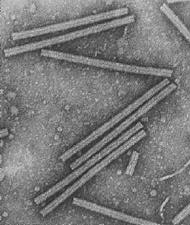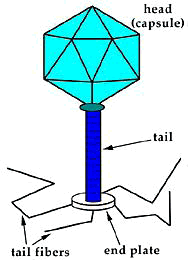

In 1898, Friedrich Loeffler and Paul Frosch found evidence that the cause of foot-and-mouth disease in livestock was an infectious particle smaller than any bacteria. This was the first clue to the nature of viruses, genetic entities that lie somewhere in the grey area between living and non-living states.
Viruses depend on the host cells that they infect to reproduce. When found outside of host cells, viruses exist as a protein coat or capsid, sometimes enclosed within a membrane. The capsid encloses either DNA or RNA which codes for the virus elements. While in this form outside the cell, the virus is metabollically inert; examples of such forms are pictured below.


Viral micrographs : To the left is an electron micrograph of a cluster of influenza viruses, each about 100 nanometers (billionths of a meter) long; both membrane and protein coat are visible. On the right is a micrograph of the virus that causes tobacco mosaic disease in tobacco plants.
When it comes into contact with a host cell, a virus can insert its genetic material into its host, literally taking over the host's functions. An infected cell produces more viral protein and genetic material instead of its usual products. Some viruses may remain dormant inside host cells for long periods, causing no obvious change in their host cells (a stage known as the lysogenic phase). But when a dormant virus is stimulated, it enters the lytic phase: new viruses are formed, self-assemble, and burst out of the host cell, killing the cell and going on to infect other cells. The diagram below at right shows a virus that attacks bacteria, known as the lambda bacteriophage, which measures roughly 200 nanometers.

Viruses cause a number of diseases in eukaryotes. In humans, smallpox, the common cold, chickenpox, influenza, shingles, herpes, polio, rabies, Ebola, hanta fever, and AIDS are examples of viral diseases. Even some types of cancer -- though definitely not all -- have been linked to viruses.
Viruses themselves have no fossil record, but it is quite possible that they have left traces in the history of life. It has been hypothesized that viruses may be responsible for some of the extinctions seen in the fossil record (Emiliani, 1993). It was once thought by some that outbreaks of viral disease might have been responsible for mass extinctions, such as the extinction of the dinosaurs and other life forms. This theory is hard to test but seems unlikely, since a given virus can typically cause disease only in one species or in a group of related species. Even a hypothetical virus that could infect and kill all dinosaurs, 65 million years ago, could not have infected the ammonites or foraminifera that also went extinct at the same time.
On the other hand, because viruses can transfer genetic material between different species of host, they are extensively used in genetic engineering. Viruses also carry out natural "genetic engineering": a virus may incorporate some genetic material from its host as it is replicating, and transfer this genetic information to a new host, even to a host unrelated to the previous host. This is known as transduction, and in some cases it may serve as a means of evolutionary change -- although it is not clear how important an evolutionary mechanism transduction actually is.
The image of influenza virus was provided by the Department of Veterinary Sciences of the Queen's University of Belfast. The tobacco mosaic virus picture was provided by the Rothamstead Experimental Station. Both servers have extensive archives of virus images.
The Institute for Molecular Virology of the University of Wisconsin has a lot of excellent information on viruses, including news, course notes, and some magnificent computer images and animations of viruses.
The Cells Alive! website includes information on the sizes of viral particles and an article on the mechanisms of HIV infection.

